Till Saturday 12 October EFSP follows Le Giornate del Cinema Muto in Pordenone. The subject of one of the retrospectives of this year's festival is William S. Hart (1864–1946), the foremost Western star of the silent era. He entered films in 1914 and achieved stardom as the lead in The Bargain (Reginald Barker, 1914). Hart was particularly interested in making realistic Westerns, and his films are noted for their authentic costumes and props. Hart also had an extraordinary acting ability, honed on Shakespearean theatre stages in the United States and England.
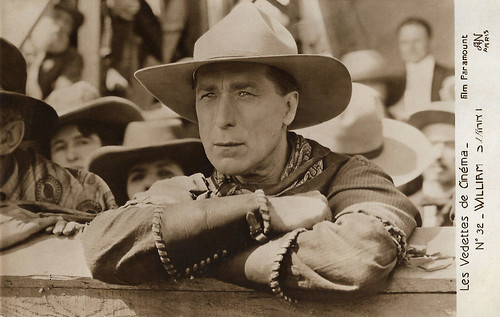
French postcard by A.N. in the Les vedettes de cinéma series, Paris, no. 32. Photo: Film Paramount.

French postcard by A.N. in the Les vedettes de cinéma series, Paris, no. 170. Photo: Film United Artists.

Swedish postcard by Förlag Nordisk Konst, Stockholm, no. 1102.
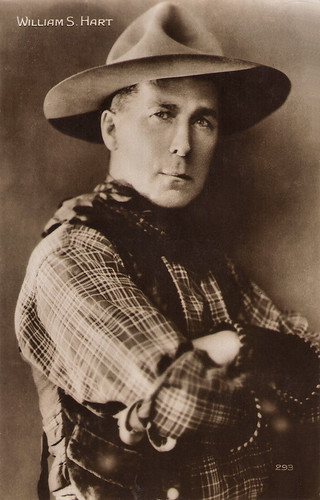
French postcard by Cinémagazine-Edition, Paris, no. 293.

Austrian postcard by Iris Verlag, no. 366. Photo: Paramount-Film.
William Surrey Hart was in 1864 in Newburgh, New York. His parents were Nicholas Hart and Rosanna Hart, and he was a distant cousin of the Western star Neal Hart. His father later worked as an itinerant millhand in remote sections of Illinois, Iowa, Minnesota, and Wisconsin. Bill grew up in unsettled areas with few white settlers, playing with Sioux children. He learned some of their words and also became adept at Indian sign language.
Hart lived for a while in the Dakota Territory, then worked as a postal clerk in New York City. In 1888 he began to study acting. He toured and travelled extensively while trying to make a name for himself as an actor, and for a time directed shows at the Asheville Opera House in North Carolina, around the year 1900. He had some success as a Shakespearean actor on Broadway, working with Margaret Mather and other stars. In 1899 he created the role of Messala in 'Ben-Hur', and later appeared uncredited in an early silent film version, Ben Hur (Sidney Olcott, Frank Oakes Rose, 1907) with Gene Gauntier. That same year, he received excellent reviews for his lead part in the stage version of 'The Virginian' (1907). In the following years, Hart established himself as one of the top interpreters of Western roles on stage.
Hart was eager to conquer the new medium of film. After playing supporting roles in two short films, including His Hour of Manhood (Tom Chatterton, 1914). he achieved stardom as a bank robber in the Western The Bargain (Reginald Barker, 1914). He regarded this feature as his true film debut. He was 49 at the time. W Morrow at IMDb: "The opening credit sequence certainly underscores the sense of a new career for the leading man: all the major players, starting with Hart, are first seen in formal contemporary attire, standing before a stage curtain. As each actor bows low, a cross-fade occurs, and he or she rises in the character makeup and costume they will wear in the film. It's a charming device and one that serves as a perfect metaphor for this important juncture in Hart's career."
In 1915 William S. Hart signed a contract with Thomas H. Ince and joined Ince's Triangle Film Company. Hart starred in his own series of two-reel Western short subjects, which were so popular that they were supplanted by a series of feature films. Many of Hart's early films continued to play in theatres, under new titles, for another decade. In 1915 and 1916 exhibitors voted him the biggest money-making star in the United States.
In 1917, he followed Ince to join Famous Players-Lasky, which merged into Paramount Pictures and received a very lucrative contract from Adolph Zukor. In the films Hart began to ride a brown and white pinto he called Fritz, the forerunner of later famous movie horses known by their own name. Hart was making feature films like Square Deal Sanderson (William S. Hart, Lambert Hillyer, 1919) and The Toll Gate (Lambert Hillyer, 1920) with Anna Q. Nillson, which were popular with fans.

American postcard by Kline Poster Co. Inc., Phila.
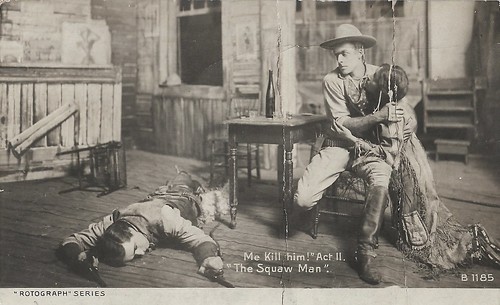
American postcard in the Rotograph series, no. B1185. Scene from Act II of the stage play version of 'The Squaw Man' by Edwin Milton Royle (1905), performed from 1905. Caption: Me Kill him! (Nat-u-Ritch has killed the evil Cash Hawkins, who wanted to kill Jim Carson aka James Wynnegate). This photo is identical to the poster that was made in 1905 by the Strobridge Co. of Cincinatti for the play (and not for the 1914 film by Cecil B. DeMille). Depicted here are William Faversham as James Wynnegate, Adrienne Morrison as Nat-u-Ritch, and (just killed) William S. Hart as Cash Hawkins.

British card in the Cinema Chat series, no. 3. Photo: Famous Players.

American postcard by Max B. Sheffer Card Co., Chicago (M.B.S.C.Co.), 1922. Photo: Paramount. William S. Hart as Oak Miller in White Oak (Lambert Hillyer, 1921).

American postcard. IMDb does not list a film with this title, closest match is Travelin'on (Lambert Hillyer, 1922), produced by William S. Hart Productions, and distributed by Paramount.
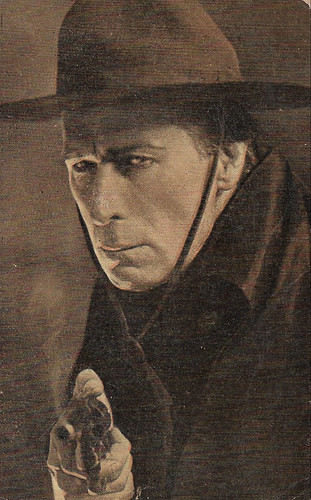
Spanish postcard by Amattler Marca Luna chocolate, series 11, no. 15.

Vintage postcard with unknown nationality and editor (US?). William Hart was known as 'The Two-Gun Man'.
During the late 1910s and early 1920s, Willam S. Hart was one of the most consistently popular movie stars, frequently ranking high among male actors in popularity contests held by movie fan magazines. At IMDb, Ed Stephan describes William S. Hart as "A storybook hero, the original screen cowboy, ever forthright and honest, even when (as was often the case) he played a villain."
From 1920 to 1925, he was the owner of his own film company, William S. Hart Productions (1920-1925) aka The William S. Hart Co. William S. Hart's career began to dwindle in the early 1920s due to the publicity surrounding a paternity suit against him, which was eventually dismissed. In 1921, Roscoe 'Fatty'Arbuckle was charged with the rape and manslaughter of aspiring actress Virginia Rappe. The case had many salacious aspects, particularly surrounding the sexual injuries found on the victim's body. Many of Arbuckle's fellow actors refused to give any comments to the press. However, Hart who had never met or worked with Arbuckle, made several damaging public statements in which he presumed the actor's guilt.
Arbuckle later wrote a premise for a film parodying Hart as a thief, bully, and wife-beater, which was bought by Buster Keaton. The following year, Keaton co-wrote, directed and starred in the comedy film The Frozen North (1922). As a result, Hart refused to speak to Keaton for many years. By that time, Hart's brand of gritty, rugged Westerns with drab costumes and moralistic themes gradually fell out of fashion. The public became attracted by a new kind of movie cowboy, epitomised by Tom Mix, who wore flashier costumes and was faster with the action. Paramount dropped Hart.
He made his last film, Tumbleweeds (King Baggott, 1925), for United Artists and retired to a ranch in Newhall, California. While living in semi-retirement in Newhall, he was disturbed by a plane which kept flying over his house. The plane was being piloted by Amelia Earhart, and they ended up becoming good friends after he invited her to dinner to complain about the noise her plane was making. By that time audiences were more interested in the antics of Tom Mix or Hoot Gibson than the Victorian moralising of Hart. Hart was a friend of legendary Wild West lawman Wyatt Earp, and along with Tom Mix, he was a pallbearer at Earp's funeral in 1929.
William S. Hart died in 1946 in Newhall and is buried in Greenwood Cemetery, N.Y. He was married to actress Winifred Westover from 1921 till their divorce in 1927. They had one child, William S. Hart, Jr. (1922–2004). He donated his estate to the City of Los Angeles, on the condition they install a fountain and use the park for the arts. Today, the internationally renowned Actors Studio has its West Coast branch at the William S. Hart Park, in West Hollywood, in Hart's old estate. His mansion in Newhall, California, is now a museum and has been preserved with its original fixtures and furnishings intact.
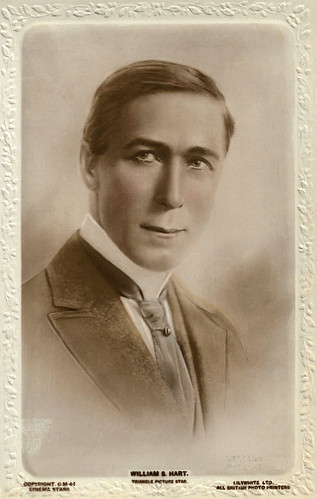
British postcard in the Cinema Stars series by Lilywhite Ltd., no. CM 44. Photo: Triangle Pictures.

French postcard by Éditions Filma in the Les Vedettes de l'Écran series, no. 82. Photo: Grandes Productions Cinématographiques.

Swedish postcard by Forlag Nordisk Konst, Stockholm, no. 1103.

French postcard by Editions Cinémagazine. Photo: Paramount.

Swedish postcard by B.H. 213. Photo: Artcraft Pictures.

French postcard by Edition Paramount, Paris.

Spanish postcard by La Novela Semanal, no. 42.

Spanish collectors card by Chocolates Amatller, Barcelona, in the 'Artistas de cine' series, no. 32: William S. Hart. Image: Martinez Surroca.
Sources: Ed Stephan (IMDb), W. Morrow (IMDb), Wikipedia and IMDb.
This post was last updated on 17 August 2024.

French postcard by A.N. in the Les vedettes de cinéma series, Paris, no. 32. Photo: Film Paramount.

French postcard by A.N. in the Les vedettes de cinéma series, Paris, no. 170. Photo: Film United Artists.

Swedish postcard by Förlag Nordisk Konst, Stockholm, no. 1102.

French postcard by Cinémagazine-Edition, Paris, no. 293.

Austrian postcard by Iris Verlag, no. 366. Photo: Paramount-Film.
Eager to conquer the new medium film
William Surrey Hart was in 1864 in Newburgh, New York. His parents were Nicholas Hart and Rosanna Hart, and he was a distant cousin of the Western star Neal Hart. His father later worked as an itinerant millhand in remote sections of Illinois, Iowa, Minnesota, and Wisconsin. Bill grew up in unsettled areas with few white settlers, playing with Sioux children. He learned some of their words and also became adept at Indian sign language.
Hart lived for a while in the Dakota Territory, then worked as a postal clerk in New York City. In 1888 he began to study acting. He toured and travelled extensively while trying to make a name for himself as an actor, and for a time directed shows at the Asheville Opera House in North Carolina, around the year 1900. He had some success as a Shakespearean actor on Broadway, working with Margaret Mather and other stars. In 1899 he created the role of Messala in 'Ben-Hur', and later appeared uncredited in an early silent film version, Ben Hur (Sidney Olcott, Frank Oakes Rose, 1907) with Gene Gauntier. That same year, he received excellent reviews for his lead part in the stage version of 'The Virginian' (1907). In the following years, Hart established himself as one of the top interpreters of Western roles on stage.
Hart was eager to conquer the new medium of film. After playing supporting roles in two short films, including His Hour of Manhood (Tom Chatterton, 1914). he achieved stardom as a bank robber in the Western The Bargain (Reginald Barker, 1914). He regarded this feature as his true film debut. He was 49 at the time. W Morrow at IMDb: "The opening credit sequence certainly underscores the sense of a new career for the leading man: all the major players, starting with Hart, are first seen in formal contemporary attire, standing before a stage curtain. As each actor bows low, a cross-fade occurs, and he or she rises in the character makeup and costume they will wear in the film. It's a charming device and one that serves as a perfect metaphor for this important juncture in Hart's career."
In 1915 William S. Hart signed a contract with Thomas H. Ince and joined Ince's Triangle Film Company. Hart starred in his own series of two-reel Western short subjects, which were so popular that they were supplanted by a series of feature films. Many of Hart's early films continued to play in theatres, under new titles, for another decade. In 1915 and 1916 exhibitors voted him the biggest money-making star in the United States.
In 1917, he followed Ince to join Famous Players-Lasky, which merged into Paramount Pictures and received a very lucrative contract from Adolph Zukor. In the films Hart began to ride a brown and white pinto he called Fritz, the forerunner of later famous movie horses known by their own name. Hart was making feature films like Square Deal Sanderson (William S. Hart, Lambert Hillyer, 1919) and The Toll Gate (Lambert Hillyer, 1920) with Anna Q. Nillson, which were popular with fans.

American postcard by Kline Poster Co. Inc., Phila.

American postcard in the Rotograph series, no. B1185. Scene from Act II of the stage play version of 'The Squaw Man' by Edwin Milton Royle (1905), performed from 1905. Caption: Me Kill him! (Nat-u-Ritch has killed the evil Cash Hawkins, who wanted to kill Jim Carson aka James Wynnegate). This photo is identical to the poster that was made in 1905 by the Strobridge Co. of Cincinatti for the play (and not for the 1914 film by Cecil B. DeMille). Depicted here are William Faversham as James Wynnegate, Adrienne Morrison as Nat-u-Ritch, and (just killed) William S. Hart as Cash Hawkins.

British card in the Cinema Chat series, no. 3. Photo: Famous Players.

American postcard by Max B. Sheffer Card Co., Chicago (M.B.S.C.Co.), 1922. Photo: Paramount. William S. Hart as Oak Miller in White Oak (Lambert Hillyer, 1921).

American postcard. IMDb does not list a film with this title, closest match is Travelin'on (Lambert Hillyer, 1922), produced by William S. Hart Productions, and distributed by Paramount.

Spanish postcard by Amattler Marca Luna chocolate, series 11, no. 15.

Vintage postcard with unknown nationality and editor (US?). William Hart was known as 'The Two-Gun Man'.
A storybook hero or a bully?
During the late 1910s and early 1920s, Willam S. Hart was one of the most consistently popular movie stars, frequently ranking high among male actors in popularity contests held by movie fan magazines. At IMDb, Ed Stephan describes William S. Hart as "A storybook hero, the original screen cowboy, ever forthright and honest, even when (as was often the case) he played a villain."
From 1920 to 1925, he was the owner of his own film company, William S. Hart Productions (1920-1925) aka The William S. Hart Co. William S. Hart's career began to dwindle in the early 1920s due to the publicity surrounding a paternity suit against him, which was eventually dismissed. In 1921, Roscoe 'Fatty'Arbuckle was charged with the rape and manslaughter of aspiring actress Virginia Rappe. The case had many salacious aspects, particularly surrounding the sexual injuries found on the victim's body. Many of Arbuckle's fellow actors refused to give any comments to the press. However, Hart who had never met or worked with Arbuckle, made several damaging public statements in which he presumed the actor's guilt.
Arbuckle later wrote a premise for a film parodying Hart as a thief, bully, and wife-beater, which was bought by Buster Keaton. The following year, Keaton co-wrote, directed and starred in the comedy film The Frozen North (1922). As a result, Hart refused to speak to Keaton for many years. By that time, Hart's brand of gritty, rugged Westerns with drab costumes and moralistic themes gradually fell out of fashion. The public became attracted by a new kind of movie cowboy, epitomised by Tom Mix, who wore flashier costumes and was faster with the action. Paramount dropped Hart.
He made his last film, Tumbleweeds (King Baggott, 1925), for United Artists and retired to a ranch in Newhall, California. While living in semi-retirement in Newhall, he was disturbed by a plane which kept flying over his house. The plane was being piloted by Amelia Earhart, and they ended up becoming good friends after he invited her to dinner to complain about the noise her plane was making. By that time audiences were more interested in the antics of Tom Mix or Hoot Gibson than the Victorian moralising of Hart. Hart was a friend of legendary Wild West lawman Wyatt Earp, and along with Tom Mix, he was a pallbearer at Earp's funeral in 1929.
William S. Hart died in 1946 in Newhall and is buried in Greenwood Cemetery, N.Y. He was married to actress Winifred Westover from 1921 till their divorce in 1927. They had one child, William S. Hart, Jr. (1922–2004). He donated his estate to the City of Los Angeles, on the condition they install a fountain and use the park for the arts. Today, the internationally renowned Actors Studio has its West Coast branch at the William S. Hart Park, in West Hollywood, in Hart's old estate. His mansion in Newhall, California, is now a museum and has been preserved with its original fixtures and furnishings intact.

British postcard in the Cinema Stars series by Lilywhite Ltd., no. CM 44. Photo: Triangle Pictures.

French postcard by Éditions Filma in the Les Vedettes de l'Écran series, no. 82. Photo: Grandes Productions Cinématographiques.

Swedish postcard by Forlag Nordisk Konst, Stockholm, no. 1103.

French postcard by Editions Cinémagazine. Photo: Paramount.

Swedish postcard by B.H. 213. Photo: Artcraft Pictures.

French postcard by Edition Paramount, Paris.

Spanish postcard by La Novela Semanal, no. 42.

Spanish collectors card by Chocolates Amatller, Barcelona, in the 'Artistas de cine' series, no. 32: William S. Hart. Image: Martinez Surroca.
Sources: Ed Stephan (IMDb), W. Morrow (IMDb), Wikipedia and IMDb.
This post was last updated on 17 August 2024.
No comments:
Post a Comment